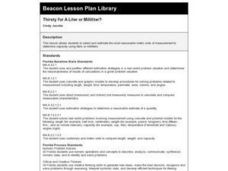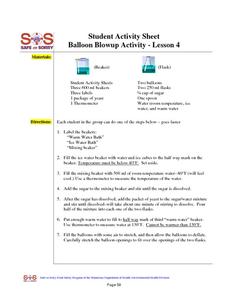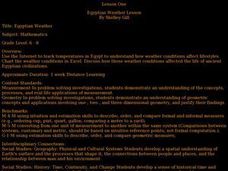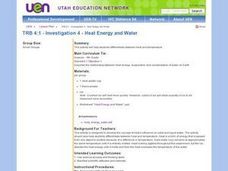Curated OER
Remote Sensing and the Electromagnetitc Spectrum
Fifth graders conclude that each color of the spectrum has a different amount of thermal energy by measuring temperature with a thermometer. They infer that there is an invisible band of the spectrum by measuring temperature beyond the...
Curated OER
Exploring Phases of Matter
Students discuss and experiment with the phases of water. In this phases of matter lesson, students recognize the different states of matter. Students measure and record changes and understand when the state changes.
Curated OER
Using A Sling Psychrometer to Determine Relative Humidity
Students create their own sling psychrometer to measure relative humidity. They work together in groups to make and use the psychrometer. They are asked questions about their experiment to complete the lesson.
Curated OER
Floating Pencil
Students discover how salt water makes a pencil float better than freshwater by measuring and comparing the lengths of the portion of the pencil that floats above the water surface. They then determine if an unknown water sample is...
Curated OER
Pounds and Ounces: It's All About Weight
First graders explore number sense by participating in a measurement estimation activity. In this weight lesson, 1st graders discuss the differences between measurement units, both English and Metric. Students examine a loaf of bread to...
Curated OER
International System of Units: Metric System
Students listen to lecture on metric system, make vocabulary book containing at least fifteen related terms, measure length, mass, and volume using appropriate metric units, and measure temperature using Celsius scale.
Curated OER
Thirsty for A Liter or Milliliter?
Second graders work with liters and milliliters for measurement.
Curated OER
Carbon Dioxide Heats It Up
Students design an investigation to test whether vegetation in an area helps regulate the ambient air temperature. They make comparisons between the investigation and global changes in climate. In groups, they present their findings to...
Curated OER
Don't Flip Out Over the Metric System
Learners identify the most appropriate metric prefix to use. They describe the usefulness of a system based on tens. Students compare the metric system to the American system of measurement. They develop a metric flip book to use a...
Curated OER
Balloon Blowup Activity
In this science activity worksheet, students will work in small groups to observe and record what happens to balloons after they are placed on flasks and immersed into a warm water bath and an ice water bath.
Curated OER
Permafrost: Permanently Frozen Ground
Students explore permafrost. In this 3 states of matter lesson, students identify characteristics of solids and liquids. Students observe water and soil melting and freezing at various temperatures. Students make...
Curated OER
Warming the Earth
First graders investigate how the sun warms the Earth and examine the rotation of the Earth and the sun. They create an illustration of the sun, examine a solar system model, and listen to the book "The Sun: Our Nearest Star." They also...
Curated OER
Energy/Light/Heat/Sound
Fourth graders study the properties of heat in this series of lessons. They discuss sources of heat and experiment to determine its properties. They identify insulators and conductors by measuring temperatures, and graphing their data....
Curated OER
Deep Freeze
Students practice various sampling methods for retrieving data under water, ice, and soil. They use the sample material to make temperature measurements, chart contents, and draw their own conclusions as to what is happening in the...
Curated OER
Cotton Seed Planting
Students using scientific inquiry will observe and record in daily journals their findings on cotton seeds. They measure, graph, and then communicate their discoveries about plants to each other.
Curated OER
Shadows
Young scholars measure shadows at different times of the day to determine when a shadow casts its longest and shortest shadows.
Curated OER
Egyptian Weather Lesson
Students chart temperatures in Egypt on spreadsheet to determine how weather conditions affect lifestyles.
Curated OER
Transforming Food Energy: A Balancing Act
Students explain their role as consumers. They use a purchased calorimeter or make their own simple calorimeter to measure the energy content in selected foods. This interesting lesson really gets students thinking about what they eat.
Curated OER
Rate of Cooling Experiment
Ninth graders measure the insulation properties of different fabrics by immersing cans of water covered with fabric "socks" in an ice bath and measuring temperature changes. They then calculate heat loss and graph the data individually.
Curated OER
Heat Energy and Water
Fourth graders brainstorm the differences between heat and temperature. In groups, they determine the best way to melt ice without touching the ice. They record their observations and compare them with other groups. To end the lesson,...
Curated OER
Heat Misconceptions
Third graders determine that gloves do not provide heat, but rather, they insulate or hold in any heat that is in their hand. They discuss the different temperatures found in ecosystems around the world. What do animals that live in...
Curated OER
Weather
For this weather worksheet, students review what causes different weather patterns including the more severe weather patterns like tornadoes and hurricanes. Students also calculate relative humidity by using dry and wet bulb...
Curated OER
Nutrition
In this nutrition worksheet, young scholars describe what nutrient is and how the energy it has is measured. Then they explain what is meant by interconversion of molecules. Students also list the common vitamins and mineral required by...
Curated OER
Nice Angle
Young scholars experiment with paper, light, thermometers and measurement to explore how the Sun's angle affects the temperature on Earth.
Other popular searches
- Measuring Temperature Math
- Measuring Temperature Lab
- Measuring Temperature Change
- About Measuring Temperature
- Winter Measuring Temperature

























